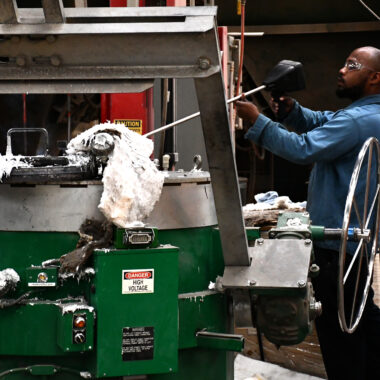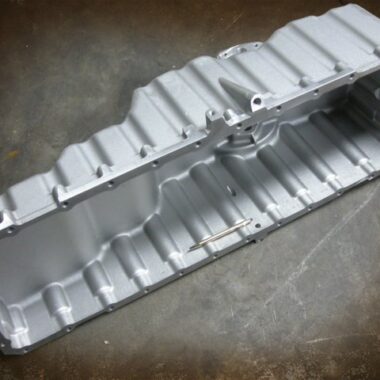Accuracy in Practice: The Art About Aluminum Casting
Accuracy in Practice: The Art About Aluminum Casting
Blog Article
Crafting Perfection: How to Achieve High-Quality Aluminum Castings Every Time
In the realm of aluminum spreading, the pursuit of perfection is a constant trip that requires a precise strategy and a keen understanding of the complexities entailed. Achieving consistent top notch aluminum castings requires a comprehensive grasp of the processes, from choosing the appropriate alloy to carrying out precise mold layouts and thoroughly regulating casting parameters.
Comprehending Light Weight Aluminum Spreading Procedures
Light weight aluminum casting processes, important in the production market, include the complex makeover of liquified light weight aluminum into strong types with a series of thoroughly controlled actions. Recognizing these processes is extremely important to accomplishing top quality aluminum spreadings constantly - about aluminum casting. The key methods made use of in light weight aluminum casting are pass away spreading, sand spreading, and financial investment casting

Each of these processes has its advantages and is selected based upon variables like intricacy, volume, and desired finish of the aluminum casting. about aluminum casting. Understanding the complexities of these techniques is critical for manufacturers aiming to produce premium aluminum castings regularly
Choosing the Right Aluminum Alloy
Selecting the ideal light weight aluminum alloy is an important decision in the production of high-quality light weight aluminum castings. The choice of alloy dramatically affects the buildings and features of the final item. Various light weight aluminum alloys offer varying levels of stamina, rust resistance, machinability, and thermal conductivity. When selecting an aluminum alloy for spreading, it is important to take into consideration the certain requirements of the application to make certain optimum performance.
Among the most frequently used light weight aluminum alloys for casting is A356. This alloy uses superb castability, high stamina, and excellent corrosion resistance, making it appropriate for a vast range of applications. 6061 aluminum alloy is favored for its premium weldability and good mechanical residential properties. For applications calling for high strength, 7075 aluminum alloy is a preferred selection due to its outstanding strength-to-weight proportion.
Along with mechanical properties, considerations such as price, schedule, and post-casting procedures need to additionally influence the choice of the appropriate light weight aluminum alloy. By meticulously evaluating these factors, suppliers can guarantee the production of top quality aluminum castings that satisfy the preferred specs.
Executing Appropriate Mold Layout
Creating a reliable mold and mildew style is important for ensuring the effective production of top notch light weight aluminum castings. Correct mold and mildew style plays a considerable role in achieving the wanted attributes of the end product. To apply an effective mold layout, aspects such as material circulation, cooling prices, and part geometry must be meticulously taken into consideration.
One secret aspect of mold and mildew design is ensuring appropriate filling and solidification of the light weight aluminum within the mold dental caries. This entails creating jogger and gating systems that promote smooth steel flow and stop flaws such as air entrapment or incomplete dental filling. In addition, including cooling networks into the mold and mildew style helps manage solidification rates and lower the risk of porosity or shrinkage issues.

Controlling Spreading Parameters

Making Certain Post-Casting High Quality Checks
To maintain the high quality of light weight aluminum castings, detailed post-casting top quality checks are necessary. After the other casting process is completed, it is essential to ensure that the last items satisfy the desired requirements and specs.
Dimensional accuracy is one more crucial facet that must be confirmed during post-casting top quality checks. Dimensions of key dimensions and tolerances should be required to validate that the castings adapt the needed specifications. Additionally, mechanical homes such as hardness, tensile stamina, and impact resistance might need to be examined via material testing to make certain that the spreadings possess the needed toughness and longevity for their intended application.
Final Thought
Finally, achieving top quality light weight aluminum castings requires a comprehensive understanding view it now of the spreading processes, choosing the appropriate alloy, creating mold and mildews properly, controlling casting parameters thoroughly, and conducting post-casting quality checks vigilantly. By adhering to these actions, makers can continually generate aluminum spreadings that meet the highest requirements of top quality and efficiency.
Attaining constant high-quality aluminum castings requires a detailed understanding of the processes, from selecting the ideal alloy to executing exact mold layouts and meticulously controlling casting specifications. The main techniques made use of in aluminum casting are die spreading, sand spreading, and investment casting.
Financial investment casting, additionally understood as precision casting, includes producing wax patterns that are covered in ceramic to create mold and mildews.Choosing the suitable light weight aluminum alloy is a vital decision in the manufacturing of premium light weight aluminum spreadings.Ensuring exact control over spreading parameters is important for preserving uniformity and high quality in light weight aluminum casting production.
Report this page